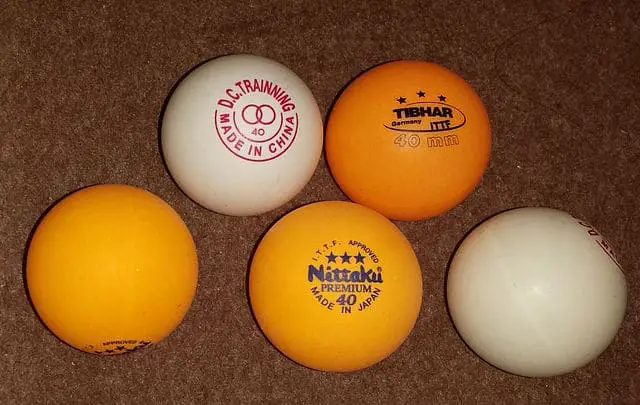Looking to find out all the information about those balls used while playing ping pong – or table tennis as it’s called in some parts of the world? Here’s everything you needed to know.
Ping pong is one of the truly global sports played all over the world, with more than 220 member countries being a part of the International Table Tennis Federation (ITTF). Ping pong has been a part of the Olympics since the 1988 Seoul games and events like the men’s and women’s singles and doubles and team events have been played.
Table of Content
What is the Official Weight & Size of a Ping Pong Ball?
According to the current international standards, the ping pong ball needs to weigh 2.7 grams (0.095 oz). Earlier, the ball diameter was 38 mm but in 2000, this was changed to 40 mm, much to the chagrin of quite a few top players. Later the balls were changed again and are called 40+ balls.
See section below on how the change proved to be a controversial one to begin with.
The ITTF has specified a competition ping pong ball’s coefficient of restitution as somewhere between 0.89 and 0.92. What this means is if released from a height of 30.5 cm (12.0 in), the table tennis ball will bounce up approximately 24–26 cm (9.4–10.2 in) from a block of steel.
Also Read:
Speed of a Ping Pong Ball
Experiments have been performed to check for the speed at which a ping pong ball is smashed. In non-match conditions, a speed of 69.9 miles/hour (112 km/hr) has been recorded but we are talking of ideal conditions here.
However, speed of the ball during a match could be slightly lesser than that.
Also for those asking if table tennis is the fastest sport around, or faster than any other racket sports, the answer to that question is no. Badminton shuttle-cocks travel quicker than ping pong balls during rallies but what gives table tennis its quickness is its close proximity due to which quicker reflexes are needed in this sport than most others.
Star Rating
There are three star ratings associated with table tennis balls.
- One Star
- Two Star
- Three Star (or ITTF-approved)
Ping pong balls are rated for their quality with one star being the lower quality balls while three star balls being of the highest quality.
Typically, one star and two star balls aren’t used in competitions because of their inferior quality and are cheaper as well. They are usually bought in bulk (dozens of them at one go) because of their lower durability.
Only the higher quality and costing three star balls are used at the highest level of the competition.
If there are companies which sell four or five star table tennis balls, it’s just an exercise in branding the balls, and a five star ball for that ping pong equipment company is nothing but a three star ball by global standards.
Also Read:
How Much do Ping Pong Balls Cost?
| Star Rating | Cost/Ball (USD) |
|---|---|
| 1 Star | 0.3-0.7 |
| 2 Star | 0.4-1.0 |
| 3 Star (ITTF Approved) | 1.0-3.0 |
The above table give an approximate price of a ping pong ball in the USA. Please remember, the cost of any sport equipment varies from country to country and is obviously different within a country too.
The prices also differ based on their star rating with the one star and two star balls obviously costing less. The three star balls, or the ITTF-approved balls are used at the highest level of table tennis and also cost the most.
One other factor to remember here is the cost/ball reduces as you order a larger set of ping pong balls. They come in a package of six or 12 or say even 72 or more.
How Long do Ping Pong Balls Last?
Ping pong balls come in packs of 12 or 24; so assuming you are looking to buy a 12-pack, three star ball, it could last up to about three months assuming, obviously you don’t lose the balls.
Lower quality balls, the one star and two stars would obviously not last as much as that. At one point, a pack of 24 such balls were exhausted in less than a month for us, but it might have been a case of a bad batch.
How to Make Balls Last Longer?
The easiest way to get ping pong balls to last longer is to buy three star rating balls. These are the highest quality balls and last way longer than others.
Other than game-play, keep the ping pong balls out of excessive heat or sunlight, and avoid getting them moist, which means store them in such a way they can be kept away from humidity too.
Don’t let table tennis balls linger on the floor when they fall to avoid letting anyone step on them.
White v Orange Table Tennis Balls
There is no difference in how different-coloured balls play in ping pong (unlike in squash where the ball colour represents something). However, choose the colour of your ping pong ball based on the background colour and that of the table.
It could also depend on the colour of the jerseys worn by the players; I mean would you want to play with a white ping pong ball if the club uniform is white? Unlikely, right?
However, high-level competitions usually use white balls despite the nostalgic value associated with watching orange ping pong balls during tournaments.
Why was the ping pong ball size changed from 38 mm to 40 mm diameter?
In more recent times, table tennis authorities have made a couple of big changes associated with the TT balls. The first change came in 2000 around the Sydney Olympics where the size of the ping pong ball was increased from 38 mm to 40 mm.
This was done in a bid to make the sport more interesting for the audience and capture more fans over the years. This change was made on the grounds it would make it tougher for the ball to travel quicker and spin lesser than usual, making the rallies go on longer and hence increase interest levels.
What were the Other Changes Made to Ping Pong (Table Tennis) Balls?
Other than the size going up from 38 mm to 40 mm, there was a second change brought about in 2014-15. Authorities opted to start using what is called non-flammable plastic or plastic balls. These balls were also slightly bigger than the 40 mm balls brought in, in 2000.
What are 40+ balls in Ping Pong?
These are the balls introduced by ITTF in place of celluloid balls, which were also called the plastic balls or the poly balls. They are called so because of the size of the ball, which is so minutely bigger than the 40 mm balls, that they are termed as 40+ balls but more vitally they are different in the material used to make them.
What was the controversy around the 40 mm ping pong ball?
For years, the table tennis authorities were unhappy about the reducing lengths of rallies in the sport. In a bid to change that around to make it a more spectator-friendly sport, the ITTF had toyed with the idea of increasing the height of the net but in the end, chose to increase the ball diameter from 38 mm to 40 mm.
Their reasoning behind this was, an increase in the overall dimensions of the ball would reduce the ball speed and take away some of the spin, thereby allowing rallies to increase.
It was ping pong’s biggest change since 1937 and obviously it wasn’t taken to very kindly. One of the reasons for this was the lack of time given to players to get used to it. The then-world number one Vladimir Samsonov from Belarus has said he would skip the World Cup because he wouldn’t have time to prepare with the new balls.
After all, the authorities had decided to continue with the previous 38 mm balls till the 2000 Sydney Olympics and bring about the change only after that.


